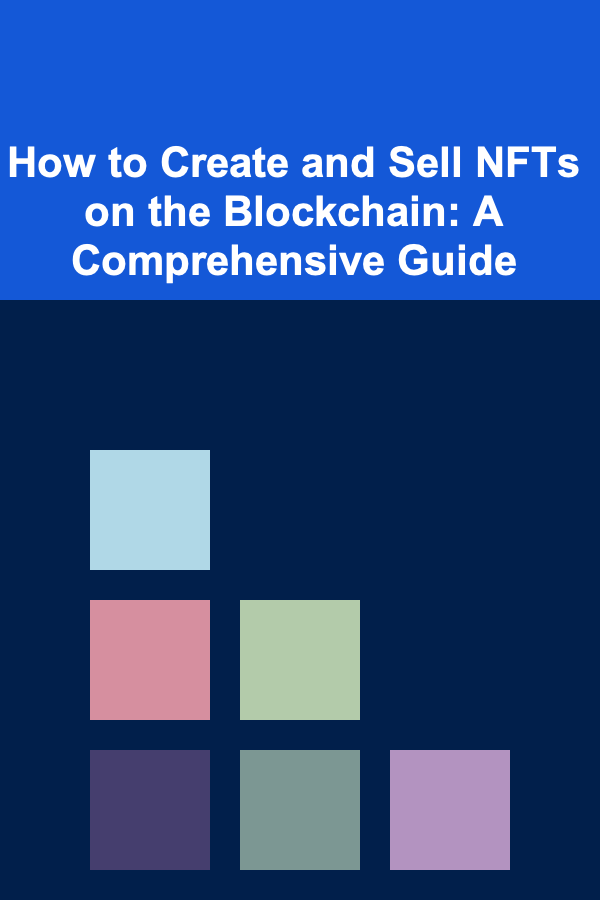
How to Create and Sell NFTs on the Blockchain: A Comprehensive Guide
ebook include PDF & Audio bundle (Micro Guide)
$12.99$7.99
Limited Time Offer! Order within the next:

Non-fungible tokens (NFTs) have revolutionized the digital landscape, providing a unique way to represent ownership of digital assets on the blockchain. From digital art and music to virtual real estate and in-game items, the possibilities for NFTs are vast and constantly expanding. This comprehensive guide will walk you through the entire process of creating and selling NFTs, covering everything from understanding the underlying technology to choosing the right platform and marketing your creations effectively.
Understanding the Fundamentals of NFTs and Blockchain
Before diving into the technical aspects of creating and selling NFTs, it's crucial to grasp the core concepts behind them and the blockchain technology that powers them.
What are NFTs?
NFTs are cryptographic assets on a blockchain with unique identification codes and metadata that distinguish them from each other. Unlike cryptocurrencies like Bitcoin or Ethereum, which are fungible (meaning one Bitcoin is interchangeable with another), NFTs are unique and cannot be replicated. This uniqueness is what makes them valuable for representing ownership of digital or even physical assets.
Here's a breakdown of key NFT characteristics:
- Non-Fungible: Each NFT is unique and not interchangeable.
- Indivisible: NFTs cannot be divided into smaller units. You can't own a fraction of an NFT (although fractionalized NFTs are emerging, they're essentially tokens representing ownership of the original NFT).
- Verifiable Ownership: The blockchain provides an immutable and transparent record of ownership.
- Metadata: NFTs contain metadata that provides information about the asset they represent. This metadata can include images, descriptions, and other relevant details.
The Role of Blockchain
NFTs reside on a blockchain, which is a distributed, decentralized, and immutable ledger. This means that the record of ownership is securely stored across a network of computers, making it virtually impossible to tamper with or forge. The blockchain also provides transparency, as all transactions related to an NFT are publicly visible.
Several blockchains support NFTs, but Ethereum is the most popular and widely used. Other notable blockchains include:
- Solana: Known for its high speed and low transaction fees.
- Polygon (Matic): A Layer-2 scaling solution for Ethereum, offering faster and cheaper transactions.
- Flow: Designed specifically for NFTs and gaming.
- Tezos: Emphasizes energy efficiency and on-chain governance.
- Cardano: Focuses on security and scalability.
The choice of blockchain depends on factors such as transaction fees, speed, environmental impact, and the target audience.
Smart Contracts: The Engine Behind NFTs
Smart contracts are self-executing contracts written in code that are stored on the blockchain. They automatically enforce the terms of an agreement when certain conditions are met. In the context of NFTs, smart contracts define the rules for creating, transferring, and managing NFTs.
The most common standard for NFTs on Ethereum is ERC-721 . This standard defines the minimum set of functions that a smart contract must implement to be considered an NFT. Another standard, ERC-1155, allows for the creation of both fungible and non-fungible tokens within the same contract, making it suitable for representing in-game items and other assets that may have varying levels of uniqueness.
Step-by-Step Guide to Creating Your NFT
Now that you have a solid understanding of the fundamentals, let's walk through the process of creating your own NFT.
1. Choosing Your Asset
The first step is to decide what type of asset you want to tokenize. The possibilities are virtually limitless, but here are some popular options:
- Digital Art: Images, illustrations, animations, 3D models.
- Music: Songs, albums, sound effects.
- Video: Short films, clips, animations.
- Collectibles: Trading cards, virtual items.
- Virtual Real Estate: Land or properties in virtual worlds.
- In-Game Items: Weapons, characters, skins.
- Domain Names: Unique and memorable web addresses.
- Memes: Popular internet jokes and images.
Consider what you're passionate about and what might appeal to collectors. High-quality, original content is crucial for success.
2. Preparing Your Asset
Once you've chosen your asset, you need to prepare it for minting. This involves ensuring that the file is in the correct format and resolution. Common file formats for NFTs include:
- Images: JPG, PNG, GIF
- Audio: MP3, WAV
- Video: MP4, MOV
- 3D Models: GLB, GLTF
Consider the file size limitations of the platform you'll be using to mint your NFT. Large files can result in higher transaction fees and slower loading times.
IPFS (InterPlanetary File System): A decentralized storage network is often used to store the actual asset file. Instead of storing the file directly on the blockchain (which can be very expensive), the NFT's metadata points to the file's location on IPFS. This provides a more cost-effective and scalable solution. Services like Pinata and NFT.Storage can help you upload and pin your files to IPFS.
3. Choosing a Blockchain and NFT Marketplace
As mentioned earlier, Ethereum is the most popular blockchain for NFTs, but other options offer different advantages. Consider the following factors when choosing a blockchain:
- Transaction Fees (Gas Fees): Ethereum gas fees can be high, especially during periods of network congestion. Solana and Polygon offer significantly lower fees.
- Speed: Solana and Flow offer faster transaction speeds than Ethereum.
- Community: Ethereum has the largest and most established NFT community.
- Environmental Impact: Ethereum's proof-of-work consensus mechanism consumes a significant amount of energy. Blockchains like Solana and Cardano use more energy-efficient proof-of-stake mechanisms.
Once you've chosen a blockchain, you need to select an NFT marketplace. Popular marketplaces include:
- OpenSea: The largest NFT marketplace, supporting Ethereum, Solana, and Polygon.
- Rarible: Focuses on community governance and allows creators to earn royalties on secondary sales.
- SuperRare: Curated marketplace for high-quality digital art.
- Foundation: Another curated platform for digital art, requiring an invitation to join.
- Nifty Gateway: Hosts exclusive NFT drops from well-known artists and brands.
- Magic Eden: Popular for Solana NFTs.
Consider the marketplace's fees, target audience, and features when making your decision.
4. Setting Up a Cryptocurrency Wallet
You'll need a cryptocurrency wallet to interact with the blockchain and NFT marketplaces. Popular wallets include:
- MetaMask: A browser extension and mobile wallet for Ethereum and other EVM-compatible blockchains.
- Trust Wallet: A mobile wallet supporting a wide range of cryptocurrencies and NFTs.
- Coinbase Wallet: A user-friendly wallet from the popular cryptocurrency exchange.
- Phantom: A popular Solana wallet.
Make sure to choose a wallet that supports the blockchain you've selected. Follow the wallet's instructions to create a new wallet and securely store your seed phrase (a 12 or 24-word phrase that allows you to recover your wallet if you lose access). Never share your seed phrase with anyone!
5. Minting Your NFT
Minting is the process of creating a new NFT on the blockchain. Most NFT marketplaces offer a user-friendly interface for minting NFTs. Here's a general overview of the process:
- Connect your wallet to the marketplace.
- Navigate to the "Create" or "Mint" section.
- Upload your asset file.
- Add metadata: This includes a title, description, and other relevant details about your NFT. Consider adding traits or properties to your NFT to make it more unique.
- Set a price (optional): You can choose to list your NFT for sale immediately or keep it private.
- Pay the gas fee: You'll need to pay a gas fee to mint your NFT. This fee covers the cost of processing the transaction on the blockchain.
- Confirm the transaction: Once the transaction is confirmed, your NFT will be minted and stored on the blockchain.
Some marketplaces offer "lazy minting," which means you don't pay the gas fee until the NFT is sold. This can be a good option if you're unsure whether your NFT will be popular.
6. Setting Royalties
One of the key benefits of NFTs is the ability to set royalties. Royalties allow you to earn a percentage of the sale price each time your NFT is resold on the secondary market. This provides a passive income stream and rewards creators for their work.
Most marketplaces allow you to set a royalty percentage when minting your NFT. Typical royalty percentages range from 5% to 10%, but you can choose any percentage you like.
Selling Your NFT
Once your NFT is minted, it's time to sell it. Here are some tips for maximizing your chances of success.
1. Pricing Your NFT
Pricing your NFT is a delicate balance. You want to set a price that is attractive to buyers but also reflects the value of your work. Consider the following factors:
- Rarity: If your NFT is particularly rare or unique, you can justify a higher price.
- Demand: If there is high demand for your work, you can increase the price.
- Market Conditions: The overall state of the NFT market can influence prices.
- Comparable NFTs: Research the prices of similar NFTs to get a sense of the market.
- Your Costs: Factor in the cost of minting, gas fees, and marketing.
You can choose to set a fixed price or list your NFT for auction. Auctions can be a good way to generate excitement and drive up the price.
2. Marketing Your NFT
Marketing is crucial for selling your NFT. Here are some effective marketing strategies:
- Social Media: Promote your NFT on platforms like Twitter, Instagram, and Discord. Engage with the NFT community and share your work with relevant hashtags.
- NFT Communities: Join NFT communities on Discord and Telegram to connect with potential buyers and collectors.
- Collaborations: Collaborate with other artists and creators to cross-promote your work.
- Press Releases: Consider issuing a press release to announce the launch of your NFT.
- Online Art Galleries: Submit your NFT to online art galleries and exhibitions.
- Paid Advertising: Use paid advertising on social media and search engines to reach a wider audience. However, be cautious as advertising for crypto-related projects can be complex and subject to restrictions.
- Engage with Collectors: Respond to comments and messages from potential buyers. Build relationships with collectors and create a loyal following.
- Create a Website or Portfolio: Showcase your NFT collection and provide more information about your work.
Highlight the unique qualities of your NFT and why it's worth collecting. Tell a story about your work and connect with potential buyers on an emotional level.
3. Engaging with Your Community
Building a strong community around your work is essential for long-term success. Engage with your followers, respond to their questions, and create opportunities for them to connect with each other.
Consider offering exclusive benefits to NFT holders, such as access to private Discord channels, early access to new drops, or physical merchandise.
Advanced Strategies for NFT Creation and Sales
Beyond the basics, there are several advanced strategies you can employ to further enhance your NFT creation and sales efforts.
1. Creating Generative Art NFTs
Generative art NFTs are created using algorithms and code. These algorithms can generate a large number of unique NFTs based on a set of rules and parameters. This allows for the creation of diverse collections with varying levels of rarity.
Tools like Art Blocks and fx(hash) are popular platforms for creating and selling generative art NFTs. Creating generative art requires programming skills and an understanding of art theory.
2. Developing Utility NFTs
Utility NFTs provide holders with specific benefits or privileges. These benefits can include access to exclusive content, discounts, membership to a community, or even real-world experiences.
Utility NFTs can be more valuable than purely collectible NFTs, as they offer tangible benefits to holders. Consider incorporating utility into your NFT projects to increase their appeal.
3. Exploring Fractionalized NFTs
Fractionalized NFTs allow you to divide ownership of a single NFT into multiple tokens. This makes high-value NFTs more accessible to a wider range of investors.
Platforms like Fractional.art allow you to fractionalize your NFTs and sell the fractions as ERC-20 tokens. Fractionalization can also provide liquidity for NFT holders.
4. Utilizing DAOs for NFT Governance
Decentralized Autonomous Organizations (DAOs) can be used to govern NFT projects. DAO members can vote on important decisions, such as the allocation of funds, the direction of the project, and the selection of new artists.
DAOs can empower NFT communities and ensure that projects are aligned with the interests of their members.
5. Understanding Legal and Tax Implications
The legal and tax implications of NFTs are still evolving. It's important to understand the potential legal risks and tax liabilities associated with creating and selling NFTs.
Consult with a legal and tax professional to ensure that you are complying with all applicable laws and regulations. Topics to consider include:
- Copyright: Ensure you own the rights to the asset you're tokenizing.
- Intellectual Property: Protect your intellectual property rights.
- Securities Laws: Be aware of potential securities law implications, especially if your NFTs offer utility or represent ownership in a project.
- Taxation: Understand how NFT sales are taxed in your jurisdiction.
Common Pitfalls and How to Avoid Them
The NFT space is rapidly evolving, and it's easy to make mistakes. Here are some common pitfalls to avoid:
- Copyright Infringement: Minting and selling NFTs based on copyrighted material is illegal and can lead to legal action. Always ensure you have the necessary rights to the asset you're tokenizing.
- Rug Pulls: Be wary of projects that promise unrealistic returns or lack transparency. Do your research before investing in any NFT project.
- Security Breaches: Protect your cryptocurrency wallet with strong passwords and two-factor authentication. Never share your seed phrase with anyone.
- Gas Fees: High gas fees can eat into your profits. Consider using a blockchain with lower fees or waiting for gas fees to drop before minting or selling NFTs.
- Lack of Marketing: Creating a great NFT is only half the battle. You need to market it effectively to reach potential buyers.
- Ignoring the Community: Building a strong community is essential for long-term success. Engage with your followers and create opportunities for them to connect with each other.
- Overpromising and Underdelivering: Don't make promises you can't keep. Be realistic about what your NFT offers and deliver on your commitments.
The Future of NFTs
NFTs are still in their early stages, but they have the potential to transform a wide range of industries. As the technology matures and adoption increases, we can expect to see even more innovative use cases for NFTs.
Some potential future applications of NFTs include:
- Metaverse Integration: NFTs will play a key role in the metaverse, allowing users to own and trade virtual assets.
- Real-World Asset Tokenization: NFTs can be used to represent ownership of real-world assets, such as real estate, art, and collectibles.
- Identity Management: NFTs can be used to verify identity and credentials.
- Ticketing and Events: NFTs can be used to create unique and secure tickets for events.
- Gaming: NFTs can be used to represent in-game items and characters, allowing players to truly own their assets.
The NFT space is constantly evolving, so it's important to stay informed about the latest developments and trends. By understanding the fundamentals of NFTs and adopting effective strategies, you can position yourself for success in this exciting new frontier.
Conclusion
Creating and selling NFTs is a complex but rewarding process. By following the steps outlined in this guide, you can successfully tokenize your assets, market them effectively, and build a thriving community around your work. Remember to stay informed, adapt to the ever-changing landscape, and always prioritize the security of your digital assets. Good luck, and happy minting!

How to Create a Fundraising Campaign Checklist for Success
Read More
How to Light Your Bathroom for a Spa-Like Experience
Read More
The Power of Deep Learning in Affiliate Marketing: Make Passive Income
Read More
How to Understand Global Economics for Profit
Read More
How to Advocate for Freshwater Ecosystem Conservation
Read More
How to Make Healthy Desserts Without Guilt
Read MoreOther Products

How to Create a Fundraising Campaign Checklist for Success
Read More
How to Light Your Bathroom for a Spa-Like Experience
Read More
The Power of Deep Learning in Affiliate Marketing: Make Passive Income
Read More
How to Understand Global Economics for Profit
Read More
How to Advocate for Freshwater Ecosystem Conservation
Read More